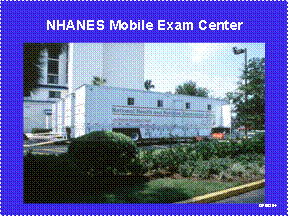
The NHANES program is unique in that it combines interviews with physical examinations and laboratory studies. The NHANES program adopted several different questionnaire data collection modes to maximize the efficiency, quality, and accuracy of questionnaire data.
In the first step of the continous NHANES survey, all participants complete an interviewer-administered questionnaire using Computer-Assisted Personal Interview (CAPI) technology. A large staff of trained interviewers, including bilingual interviewers, conduct these interviews in participants' homes.
The slide below shows a pentop handheld computer, which is currently used for the CAPI-administered household interviews.

Participants sign consent forms for participating in the interview and physical examination. The physical examination generally occurs within 1 to 2 weeks after the in-home interview.
All physical examinations are performed in a set of specially-designed and equipped Mobile Examination Centers (MEC), which travel to survey locations throughout the country. The survey team currently consists of a physician; medical and health technicians; and dietary and health interviewers.

To ensure that all physical examination and lab data are collected in standardized fashion, and in order to minimize site-specific errors, the MEC and examination team provide standardized:
The MEC houses the state-of-the-art exam equipment and is divided into rooms to assure the privacy of each study participant during the exams and interviews. The full examination for an adult takes approximately 3½ hours, but the actual length depends on the study participant's age. The staff at the mobile exam center can automatically transmit exam data into databases through such devices as digital scales and stadiometers.
The laboratory component includes the collection and processing of various biological and environmental specimens including blood for study participants 1 year and older, and urine for subjects 6 years and older. On-site pregnancy testing excludes pregnant women from other examination components such as DEXA, BIA, and cardiovascular fitness testing. Complete Blood Counts (CBCs) are also performed in the MEC laboratory. Three medical technologists conduct the on-site clinical laboratory tests on biological and environmental specimens, record the results of the tests, and prepare and ship specimens to various laboratories. All other specimen testing is performed by Federal, private, and university-based laboratories under contract to NCHS.
During the MEC Examination, participants complete additional interviewer-administered survey questionnaires, including a dietary questionnaire, and questionnaires on selected special topics. CAPI is used to collect these data.
Selected groups of participants are also asked to complete questionnaires on other topics, such as illicit drug use or sexual behaviors. Because of the sensitive nature of these topics, participants fill out these questionnaires themselves, using Audio Computer-Assisted Self Interview (Audio-CASI) technology.
Currently, participants who have completed the MEC dietary questionnaire participate in two follow-up questionnaire activities. They complete a telephone interview with survey staff using Computer-Assisted Telephone Interview (CATI) and fill out a food frequency questionnaire.